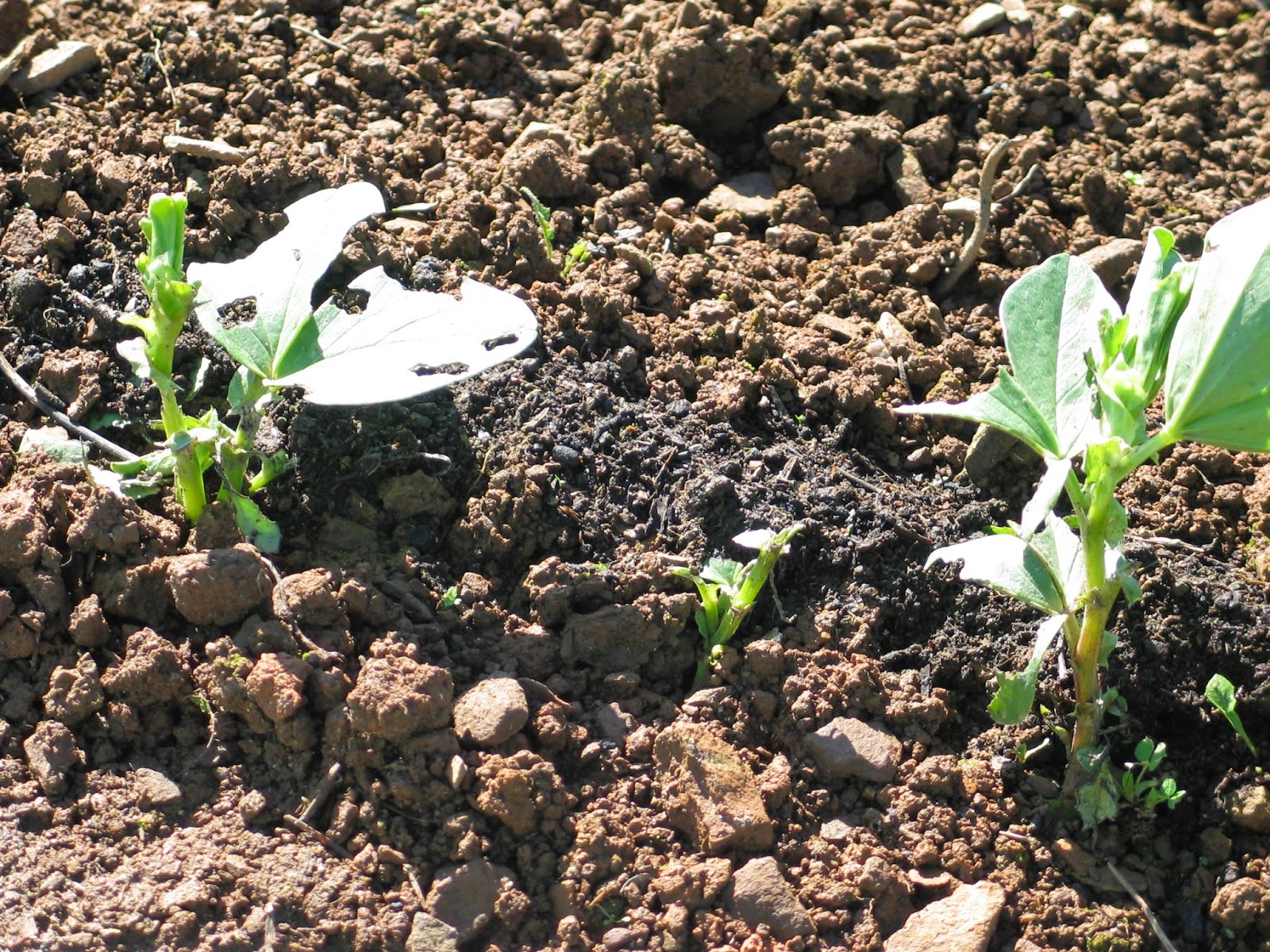Just take our broad beans. We sow them in different places. They grow up very different and there are some in very bad shape. And moreover it had also been raining very terrible hard, so that almost the entire crop was lying flat on the ground. You would think that the poor continue to do poor, and the good will be well. But no. The poor are now full with beans, and the good... I've cleaned them up because there was no bean to be seen. How can that be? This is food for thought ... would you have to give broad beans a good spanking, to live well and healthy? Or is it bit more subtle?
Meanwhile we had a shade cloth hung to protect the other seeds against the fierce sun. Because the sunshine is hot, between showers. You can not leave plastic pots in the sun, as they get hot, then the soil in the pots gets hot. This obviously has implications for the plant.
That broad beans do not need much, we already knew actually. And now we see how. They need no more then some red Portuguese earth, some old compost, adequate sunlight and sufficient space under there feet. It is a plant with a root system that is quickly expanding. In addition, it is a legume, which makes root nodules, bringing nitrogen into the soil. This root system gets stuffy in a pot very soon. It reminds me of a prisoner, who wants to break out. And it likes lots of water every day, to quench its thirst, while the pot is empty very soon. All this makes the plant grow but produce no beans. Nature is smart. If you have the idea that you can not reproduce your kind, you do not have children. For that matter, we can still learn from this.
If a broad bean plant is in the ground, it will always find its water anywhere. If it is not at the surface, it will find it in deeper layers. To sun and rain, It has enough. Storm and wind seems to keep its growth. Because resistance is doing to fight, to survive. And what a plant can do best, if it wants to survive? Right, make offspring ... beans.
It was not the intention, but it has become a nice comparison test. In the future I do not grow my beans in pots. And I no longer shelter it from the elements, with shade cloths and a quiet and wind free corner. Beans want to see the sun and have there feet in the free soil, with the head in the wind. I can imagine at some.
Something like this I have experienced with cabbage last year. A cabbage plant also wants to see more earth than it has available in a pot. Transplanting a 'miserable existence' in a pot, to the open ground in the valley behind the house, turned out to be a relief. They were like cows in spring, when they are led to the meadow. If cabbage plants could jump, they had done it. What they could do was to flourish, turn dark green and make a beauty of a cabbage. And that happened.
Well it was true, that the cabbage down in the garden were attacked more by butterflies. An egg was easily laid. But by checking for caterpillars, during the transition from poor to healthy cabbage, this suffering ended soon. For a caterpillar, a healthy cabbage seems to be not as far so good then a poor cabbage. Life is hard.
So there you have it. We have to take care of what is ill and must leave some fairly what is healthy and strong. So we also see that one can make ill what is healthy by unnecessary protection. It is our task to figure out what is healthy or sick. And in order to make it difficult, sick and healthy are relative concepts. Because what seems ill can be very healthy and what seems somewhat healthy can collapse under its own prosperity.
To quote the late Dr. William Albrecht: "You have to have a vision. Unless you do, nature will never reveal herself."
I have noticed that you can get a vision by watching and trying to record, by trying to understand what is happening. Sometimes it succeeds. And along the way you collect a lot of knowledge.
*
One final note, not least: Once we sowed broad bean seeds, we had harvested from our garden the previous season. So, our own seed. We grew beautiful plants and beautiful flowers also... but no beans. Our conclusion was that the plants from which we harvest the seeds, must have been hybrid.
Here, however, the seeds all came from one bag. So...
Stella.
April 2016:
Eventually we learned it anyway... Beautiful healthy broad beans we grow in our clayey soil, including a wheelbarrow old compost from a previous culture in pots. Sown in the last week of November, 20 cm. on the row and a minimum of 60 cm. between the rows. In February, they are already quite high, nicely with there heads in the wind. In March, we want to cut the tops, but it does not seem necessary, because there is almost no lice to be seen. In April, they are large enough to be picked. Thanks to the rain we did not need to water them so much. And it was not so hot that we needed a shade cloth. So the circumstances were favorable also...
May 2016.
In the last week of November 2015 we sowed 24 beans. Multiple stems grew from every bean; 3, 5 and occasionally even 7. All stems produced several beans; 5, 7 to occasionally even 13. From the 24 seeds we eventually harvested three full buckets with pods, of 15 liters.
*
Stella.























Geen opmerkingen:
Een reactie posten